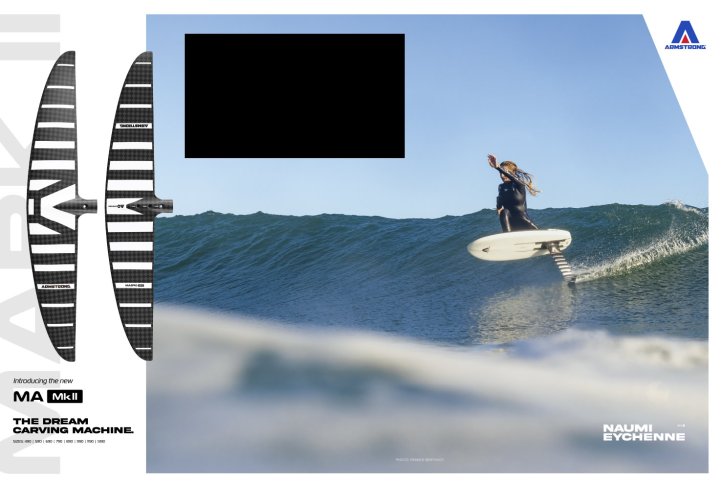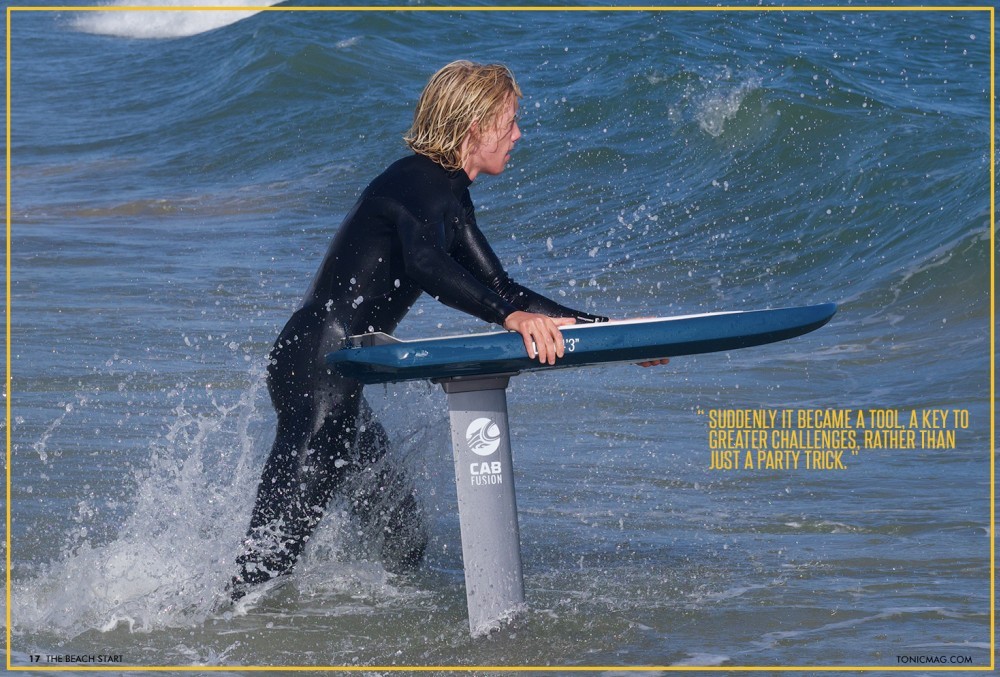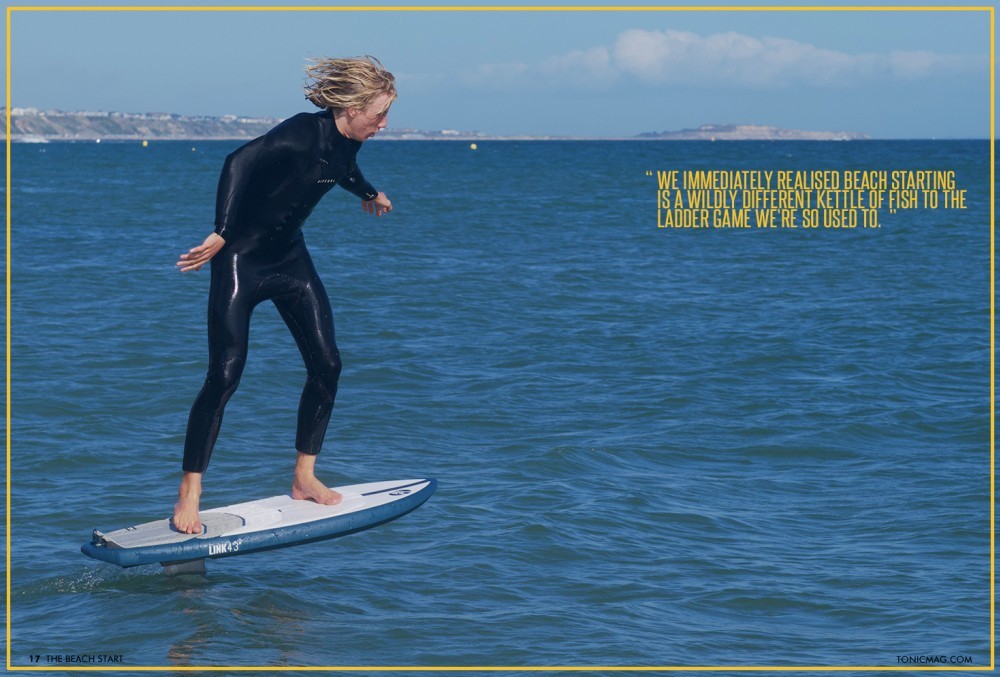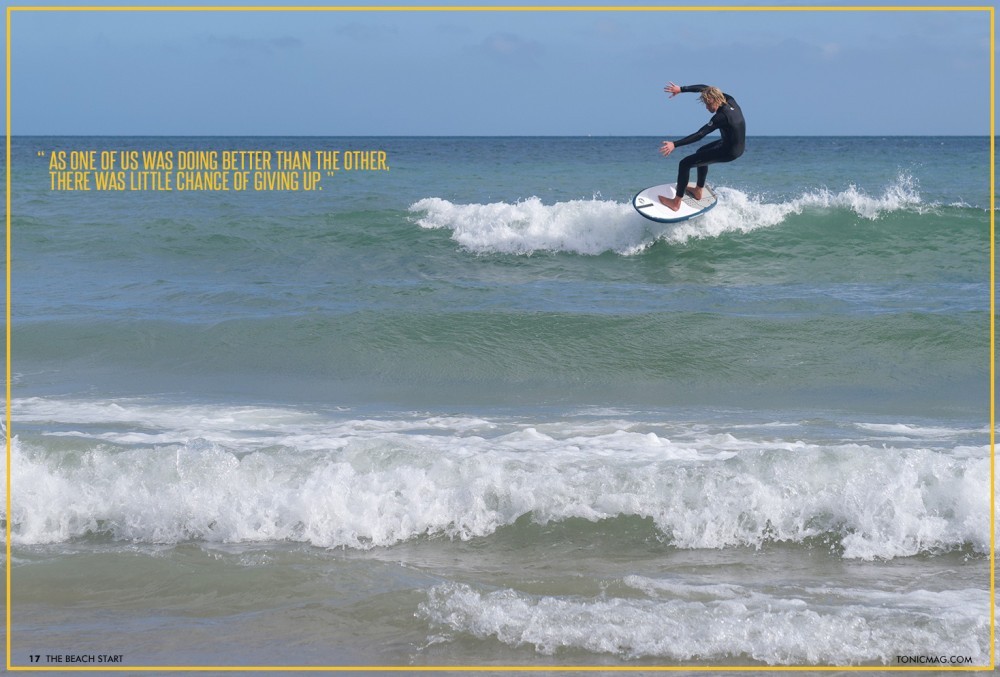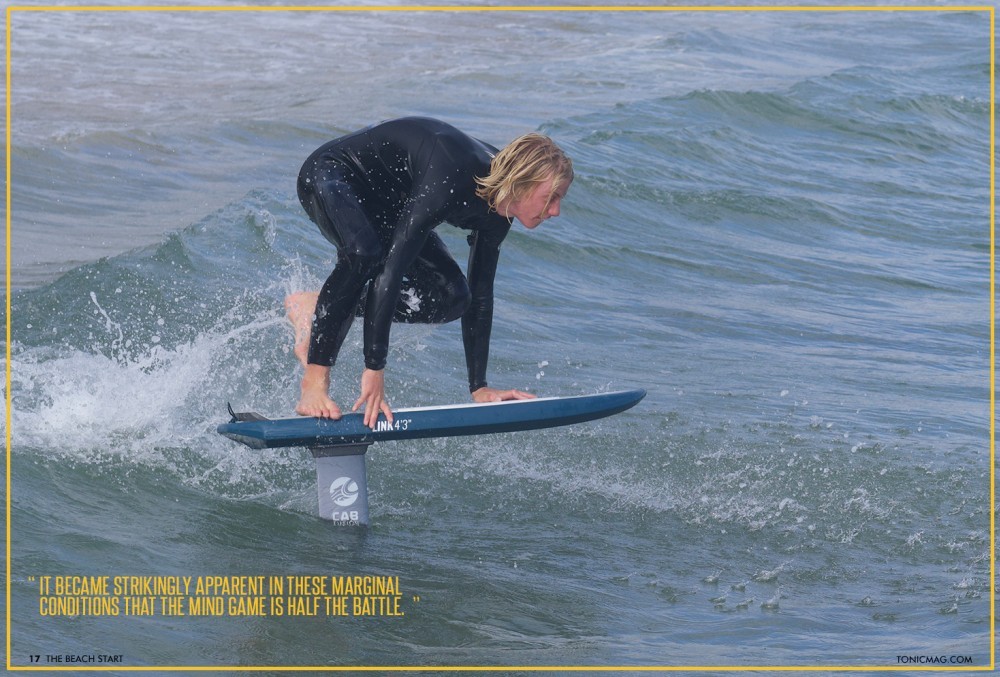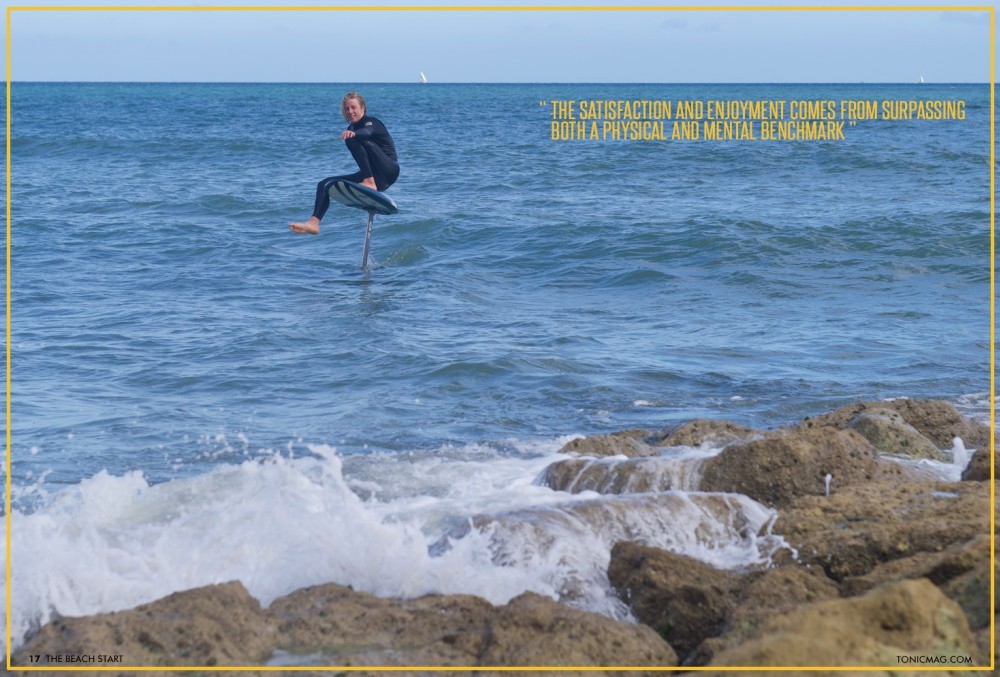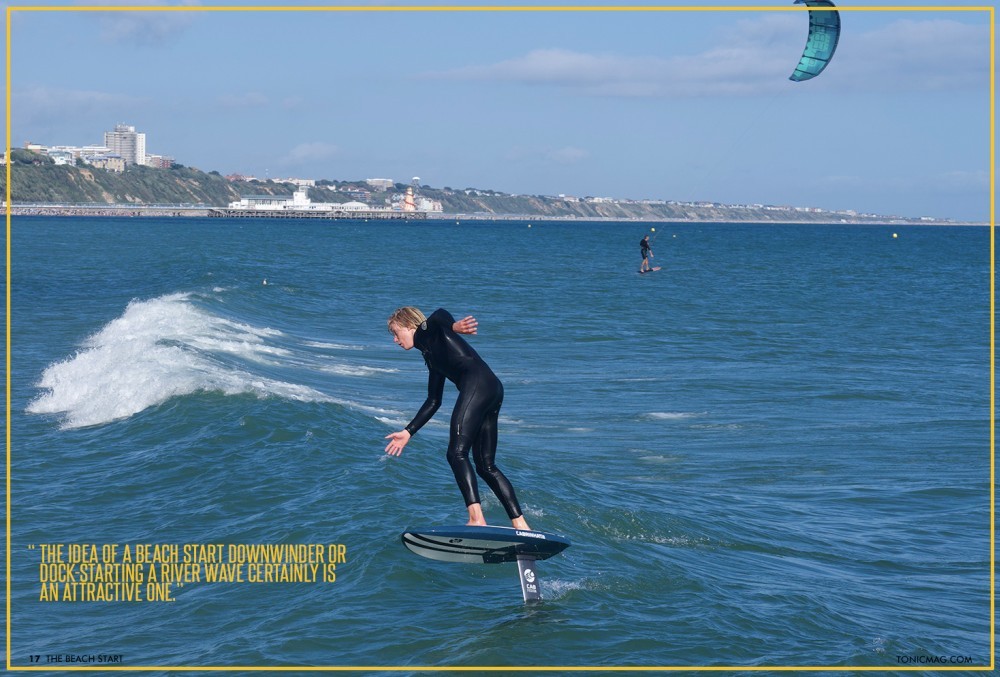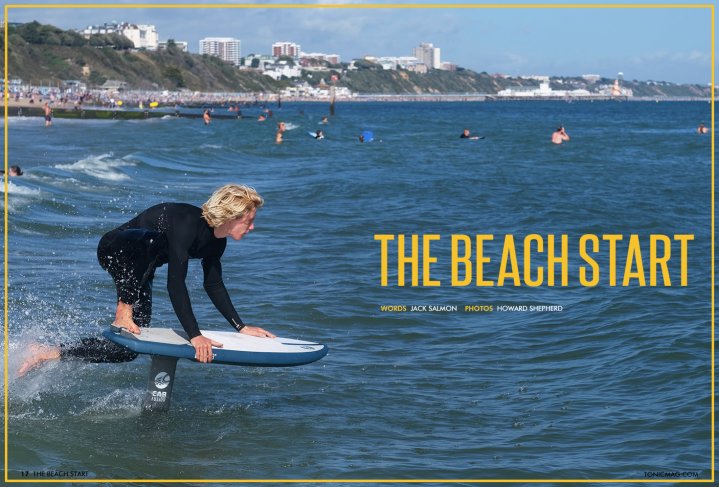
The Beach Start - Jack Salmon
Issue 17 / Mon 4th Sep, 2023
Here, Jack Salmon breaks down his learning process of the beach start over a couple of sessions with our editor Jack Galloway.
The idea of trying beach starts had been bouncing around in my mind for quite some time. A concept toyed with but never acted on, obsolete since the use of the ladder for pump foiling.
Then one afternoon, out of the blue, Jack Galloway sent me a video of Nathan van Vuuren beach starting with effortless steeze out to the lineup of some pumping swell. The appeal was not necessarily in the beach start itself, but the possible application. Suddenly it became a tool, a key to greater challenges, rather than just a party trick.
I found myself driving into the carpark at Branksome Dene Chine that overcast afternoon unsure what to expect.
Jack is a bit of a legend around here at pump foiling and I have been heading out with him with the ladder recently whenever there is a calm day to mess around. In other words we’re both confident pump foilers, but the beach start presented a new, altogether more athletic challenge.
I assemble my Cabrinha 1650 X Series Mark II with a 75cm mast. Though the mast was on the long side (especially considering Jack’s was 65cm), I was convinced the foil was the tool for the job. It’s crazily low stall speed coupled with a fair amount of glide allowed for so much room for error whilst dock starting, and I was to need every inch I could get for this new challenge.
My confidence quickly wears off. We plod down the beach towards the sea feeling like a fish out of water, naked without the trusty ladder that has become an integral part of our pump foiling, remarking what a strange sight we must look to the few onlookers on this gloomy evening.
We rigorously check the depth to stall things further. The beach here is by no means perfect. It drops off moderately steeply until around the length of my mast (75cm) where it flattens off considerably. This didn’t give much room for error – technique would have to be excellent in order for the foil not to run aground.
Jack takes the first turn with little success aside from a spectacular flop of a wipeout.
Once the runway is clear I waddle unsteadily through the water before making a half-hearted attempt at hopping onto the board. My back foot misses by a mile and I explode into a messy tangle of foil and limbs.
We immediately realised beach starting is a wildly different kettle of fish to the ladder game we’re so used to. While with the ladder both hands are further back on the board, approximately where the feet end up, for the beach start we felt the need to bring both hands further toward the nose to hold the foil down when running through the water.
Clumsily charging into the sea, we take it in turns to throw ourselves at the board with very little initial success, and excellent wipeouts all round. I ask when we are going to assemble the ladder, convinced the beach start is a foolish pursuit and we set ourselves a 30 minute time limit to nail it.
Then without warning Jack bounces up and lands with both feet planted on the board. Gliding for a split second before veering off balance, the manoeuvre looks reminiscent of a beach start. From then on it was a given. We were going to crack it.
Both Jack and I are fiercely competitive and (though I’m not sure either of us are readily willing to admit it) as long as one of us was doing better than the other, there was little chance of giving up.
Suddenly I’m flying. Succeeding to stay high on the mast I manage a strong two footed pop well timed with incoming swell to keep me elevated, and through nothing more than lucky timing I’m up and away. There is an extremely satisfying flow to a successful beach start, with the rhythmic steps of the run weaving seamlessly into the cadence of the pump, so I’m buzzing once I return to the beach.
In no time Jack also follows and pumps in towards the beach beaming, similarly frothing to have nailed the unexpected.
It’s not long before the novelty wears off and we are back at it. With the mental barrier demolished, more follow, this time on camera.
Soon the tide drops enough that my board is becoming a monumental leap to keep the foil high enough to not run aground. This compounded with tiredness was a killer combo and my successes slowly waned.
Jack on the other hand was improving with every attempt, first 3 in a row, then 5, he was consistently landing feet centred and mast high, and incredibly ended the session having gone from zero to hero in the course of just over an hour.
A few nights later we spot a windless evening coupled with a high tide and rush down to the beach after work, itching to get back out and nail the beach starts consistently.
This time we saunter down with confidence, but are dismayed to find the beach plateaus at lower than waist (and mast) height. I almost immediately give up and bitterly wander off to set up the ladder, but watching Jack persevere on the beach starts proved too much for me, and I hesitantly, somewhat reluctantly resume.
It became strikingly apparent in these marginal conditions that the mind game is half the battle. Commitment is key. I pause before the run up as if readying myself for a race, waiting for a set wave to start … three, two, one, go! … max acceleration in four rhythmic steps leads into a two footed pop to jump up onto the board a split second before feeling the small wave satisfyingly lift the mast high.
The half foot swell saves the day. When the jump onto the board is well timed with an oncoming wave it provides the necessary lift to stay high on the mast in the split second of gliding into deeper water before pumping starts.
We kept it up until light became the major issue. For both Jack and I, consistency was still not a given, but I drive home satisfied that I could at least comfortably claim to be able to beach start, and ready to build some new challenges upon this skill.
Interestingly, we have retained quite different techniques. I use a longer run up and more of a front footed bound, landing back foot first, whereas Jack has a short run up with a strong two footed hop landing both feet with equal timing. Both seem to work similarly well, so proving experimentation and variation is key in the early stages.
A few people have remarked to me that beach starting seems boring and whether it’s a joke or not I know there is an element of truth behind what they say. However, it seems to me that we appreciate it for a different reason to winging or surf foiling. The satisfaction and enjoyment comes from surpassing both a physical and mental benchmark, a challenge much like nailing a technical trick on the skateboard, or learning a new tack on a kite foil, rather than the speed and adrenaline that characterises most other foiling disciplines, but the flow so synonymous with foiling is felt nonetheless.
Though the novelty arguably wears off quicker, it provides a foundation for greater challenges. Who knows where this might lead for us? The idea of a beach start downwinder or dock-starting a river wave certainly is an attractive one.
So if you like a challenge, then I urge you to get down to the beach on a flat day, pop on your largest wing and give it a go!
Key tips from a (very) amateur beach starter:
- Hold the board further forward to keep the foil down when running into the water.
- Try a two footed pop, looking to plant back foot on the board first.
- A small shorebreak wave helps when the spot is shallow.
- Commitment is key.
- Persevere!! Go with someone else, there’s nothing like a bit of healthy competition.
By Jack Salmon


